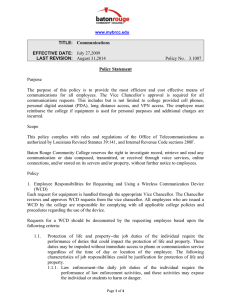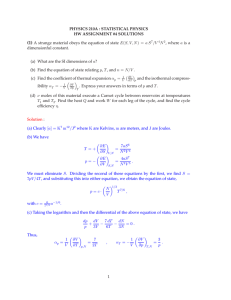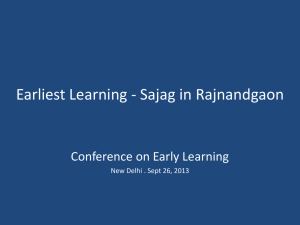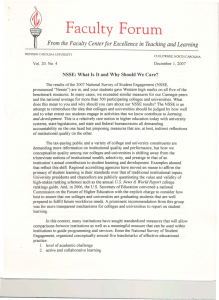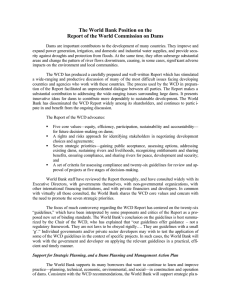Goal Recognition Design Sarah Keren, Avigdor Gal Erez Karpas
advertisement
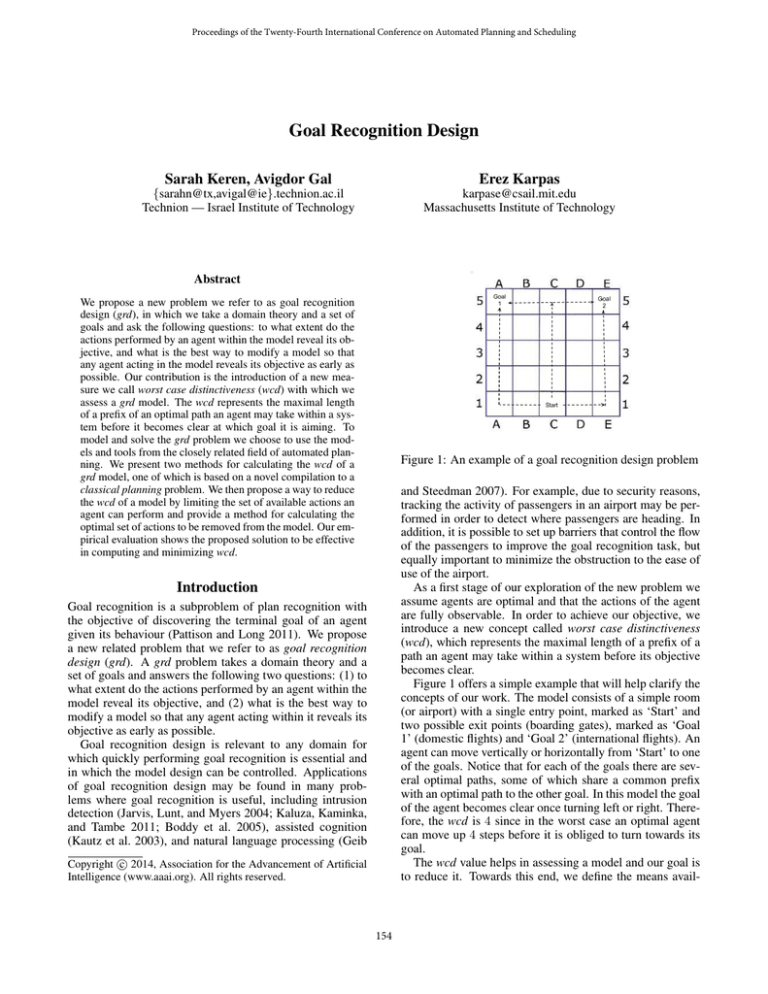
Proceedings of the Twenty-Fourth International Conference on Automated Planning and Scheduling
Goal Recognition Design
Sarah Keren, Avigdor Gal
Erez Karpas
{sarahn@tx,avigal@ie}.technion.ac.il
Technion — Israel Institute of Technology
karpase@csail.mit.edu
Massachusetts Institute of Technology
Abstract
We propose a new problem we refer to as goal recognition
design (grd), in which we take a domain theory and a set of
goals and ask the following questions: to what extent do the
actions performed by an agent within the model reveal its objective, and what is the best way to modify a model so that
any agent acting in the model reveals its objective as early as
possible. Our contribution is the introduction of a new measure we call worst case distinctiveness (wcd) with which we
assess a grd model. The wcd represents the maximal length
of a prefix of an optimal path an agent may take within a system before it becomes clear at which goal it is aiming. To
model and solve the grd problem we choose to use the models and tools from the closely related field of automated planning. We present two methods for calculating the wcd of a
grd model, one of which is based on a novel compilation to a
classical planning problem. We then propose a way to reduce
the wcd of a model by limiting the set of available actions an
agent can perform and provide a method for calculating the
optimal set of actions to be removed from the model. Our empirical evaluation shows the proposed solution to be effective
in computing and minimizing wcd.
Figure 1: An example of a goal recognition design problem
and Steedman 2007). For example, due to security reasons,
tracking the activity of passengers in an airport may be performed in order to detect where passengers are heading. In
addition, it is possible to set up barriers that control the flow
of the passengers to improve the goal recognition task, but
equally important to minimize the obstruction to the ease of
use of the airport.
As a first stage of our exploration of the new problem we
assume agents are optimal and that the actions of the agent
are fully observable. In order to achieve our objective, we
introduce a new concept called worst case distinctiveness
(wcd), which represents the maximal length of a prefix of a
path an agent may take within a system before its objective
becomes clear.
Figure 1 offers a simple example that will help clarify the
concepts of our work. The model consists of a simple room
(or airport) with a single entry point, marked as ‘Start’ and
two possible exit points (boarding gates), marked as ‘Goal
1’ (domestic flights) and ‘Goal 2’ (international flights). An
agent can move vertically or horizontally from ‘Start’ to one
of the goals. Notice that for each of the goals there are several optimal paths, some of which share a common prefix
with an optimal path to the other goal. In this model the goal
of the agent becomes clear once turning left or right. Therefore, the wcd is 4 since in the worst case an optimal agent
can move up 4 steps before it is obliged to turn towards its
goal.
The wcd value helps in assessing a model and our goal is
to reduce it. Towards this end, we define the means avail-
Introduction
Goal recognition is a subproblem of plan recognition with
the objective of discovering the terminal goal of an agent
given its behaviour (Pattison and Long 2011). We propose
a new related problem that we refer to as goal recognition
design (grd). A grd problem takes a domain theory and a
set of goals and answers the following two questions: (1) to
what extent do the actions performed by an agent within the
model reveal its objective, and (2) what is the best way to
modify a model so that any agent acting within it reveals its
objective as early as possible.
Goal recognition design is relevant to any domain for
which quickly performing goal recognition is essential and
in which the model design can be controlled. Applications
of goal recognition design may be found in many problems where goal recognition is useful, including intrusion
detection (Jarvis, Lunt, and Myers 2004; Kaluza, Kaminka,
and Tambe 2011; Boddy et al. 2005), assisted cognition
(Kautz et al. 2003), and natural language processing (Geib
c 2014, Association for the Advancement of Artificial
Copyright Intelligence (www.aaai.org). All rights reserved.
154
Background: Classical Planning
(a) A non-optimal solution
The basic form of automated planning, referred to as classical planning, is a model in which the actions of the agents
within it are fully observable and deterministic. A common way to represent classical planning problems is the
STRIPS formalism (Fikes and Nilsson 1972). A STRIPS planning problem is a tuple P = hF, I, A, G, Ci where F is
the set of fluents, I ⊆ F is the initial state, G ⊆ F represents the set of goal states, and A is a set of actions. Each
action is a triple a = hpre(a), add(a), del(a)i, that represents the precondition, add, and delete lists respectively, and
are all subsets of F . An action a is applicable in state s if
pre(a) ⊆ s. If action a is applied in state s, it results in the
new state s0 = (s \ del(a)) ∪ add(a). C : A → R0+ is a cost
function on actions, that assigns each action a non-negative
cost.
Given a planning problem, the objective is to find a plan
π = a1 , . . . , an , a sequence of actions that brings an agent
from I to a state that satisfies the goal. The cost c(π) of a
plan π is Σ(c(ai )). Often, the objective is to find an optimal
solution for P , an optimal plan, π ∗ , that minimizes the cost.
We assume the input of the problem includes actions with a
uniform cost equal to 1. This means that plan cost is equivalent to plan length, and the optimal plans are the shortest
ones.
(b) An optimal solution
Figure 2: Solutions for reducing the wcd
able for modifying a model. Since we want to limit the set
of possible optimal paths of an agent, an elegant way of introducing changes into the model is by limiting the set of
available actions an agent can perform. As a way of maintaining “user comfort” in the model we require the solution
to preserve the original optimal solution length of all goals.
In addition, given the maximal reduction achieved while respecting this constraint, we wish to minimize the change introduced to the model.
In our motivating airport example, the solution of placing
barriers or screens in order to direct the flow of passengers
is a common and effective solution. Figure 2 portrays two
possible solutions that reduce the wcd of a model from 4
to 0. Clearly, the option in Figure 2(b) is preferable since
it offers the same result by disallowing a single action and
creating a single barrier.
Goal Recognition Design
We define a goal recognition design (grd) problem as a tuple D = hPD , GD i, where PD = hF, I, Ai is a planning
domain formulated in STRIPS and GD is a set of possible
goals G, G ⊆ F (whenever D is clear from context we will
use P and G). It is worth noting that the model includes an
initial state, common to all agents acting in the system. In
case there are multiple initial states, there is a simple compilation, which adds a zero cost transition between a dummy
common initial state and each initial state, making the model
and the methods we propose applicable.
Given a grd problem, our objective is to find a measure
that assesses the ability to perform goal recognition within
the model and compute it. Once such a measure is established, we would like to modify the model such that the
recognition ability is maximized, while respecting the specified constraints. There are several issues that need to be
explained: first, we need to define a measure for the ability
to recognize the objective of an agent in a concrete form and
what it means to maximize it. Secondly, we need to make
precise the allowed modifications to the model that have the
potential of improving this ability. Before we elaborate on
these two issues we detail three assumptions on which our
model is based.
1. Agents in the system are acting optimally,
2. the outcomes of the actions are deterministic, and
3. the model is fully observable to the agent and system.
The removal of any combination of these assumptions creates an interesting scenario and a challenging problem to
solve. However, as a first stage we want to keep our model
as straightforward as possible and defer more complex problems to future work.
Goal recognition design, while relevant to goal recognition — interchangeably called in the literature plan recognition (Kautz and Allen 1986; Cohen, Perrault, and Allen
1981; Lesh and Etzioni 1995; Ramirez and Geffner 2009;
Agotnes 2010; Hong 2001) — is a totally different task.
While goal recognition aims at discovering the goals (and
sometimes plans) of an agent according to observations of
its actions collected online, goal recognition design does not
include a specification of an observation sequence, but rather
offers an offline solution for assessing and minimizing the
maximal number of observations that need to be collected in
order to assure the goal of any optimal agent in the system
is recognized.
To model and solve the grd problem we choose to use the
models and tools from the closely related field of automated
planning. The advantage of this choice is that by compiling
our problem into a classical planning problem we gain the
option of using various established tools and techniques.
The paper is organized as follows. We start by providing the necessary background on classical planning. We
continue by introducing the formal model representing the
grd problem and the wcd value. The following sections
present the methods we developed for calculating and reducing the wcd value of a given grd problem. We conclude
with an empirical evaluation, a discussion of related work,
and a conclusion.
155
Theorem 2 For a plan recognition model defined by the tuple T = hD, Oi, in which O represents the full sequence
of actions performed by an agent, if |O| > wcd(D) then
∗
0 ≤ |GO
| ≤ 1.
We start by defining what it means for the goal of the
agent to be clear. As mentioned above, we are concerned
with the design of a model and not with the behaviour of a
specific agent. Accordingly, we need to recognize the options an agent may have within a model and examine the
characteristics of the various paths available. Let Π∗ (G)
represent the set of optimal paths to G.
Proof: By definition, wcd(D) represents the maximal prefix
a set of more than one goal in G may share. If the set O is
the full sequence of observations it represents the prefix of
the path of the agent, therefore, if it is bigger than wcd(D),
∗
then 0 ≤ |GO
| ≤ 1.
Definition 1 Given a problem D = hP, Gi, a sequence of
actions π is a non-distinctive path in D if ∃G0 , G00 ∈ G s.t.
G0 6= G00 and ∃π 0 ∈ Π∗ (G0 ) and π 00 ∈ Π∗ (G00 ) s.t. π is a
prefix of π 0 and π 00 . Otherwise, π is distinctive.
A key issue to notice regarding the calculation of the
wcd value of a model is that, as opposed to classical planning
problems in which we are interested in finding any optimal
path to the goal, or goal recognition problems in which we
are interested in finding any optimal path that fits a set of
observations, in our problem we need to take into account
all optimal paths to the relevant goals.
A basic way to discover all paths to all goals within a
model is to perform an exhaustive exploration of the state
space using, for example, a BFS tree search. The BFS tree
search starts at the initial state and explores, at each level, all
states that are reachable from the previous level. The search
continues up to the level in which the most distant goal is
found. The result is a tree depicting all paths of length up
to the length of the longest optimal path, including all optimal paths to all goals in G. In order to reveal the wcd value
of the model, we need to find the set of goals that share the
longest non-distinctive path. We can do this by performing
a backward search starting at the most distant leafs, and advancing one level at time, marking for each node the goals
on which it appears on an optimal path, and stop once a node
that appears on the path to more than one goal is discovered.
Although this method is sound, it is highly inefficient, especially in scenarios in which there are many optimal paths
to each goal. We next present two methods for finding the
wcd of a model, which both rely on Corollary 1 to reduce
the state space that is explored.
We aim at creating a model in which agents reveal their
goal as early as possible. The wcd value we propose serves
as an upper bound on the number of actions any optimal
agent can perform in a model before revealing its goal by
selecting a distinctive path. Using the definition above, we
can formally define the wcd value of a model as follows.
Definition 2 Let ΠD = hπ|π is a non-distinctive path of Di
and let |π| denote the length of a path π. Then, worst case
distinctiveness (wcd) of a model D, denoted by wcd(D), is:
wcd(D) = max |π|
π∈ΠD
Finding wcd
In this section we describe two methods to calculate the
wcd of a model, both based on the following observations.
Theorem 1 If π is non-distinctive, any prefix of π is nondistinctive.
Proof: According to Definition 1, the fact that π is nondistinctive means that ∃π 0 , π 00 , G0 , G00 s.t. π 0 ∈ Π∗ (G0 ) and
π 00 ∈ Π∗ (G00 ) and π is a prefix of both π 0 , π 00 . This in turn
means that any prefix of π is necessarily a prefix of both π 0
and π 00 , and therefore non-distinctive.
wcd-bfs
The first solution we present is a variation of the BFS tree
search presented above — only instead of blindly exploring
all paths in the model we trim the search by pruning the
nodes that represent distinctive paths. Corollary 1 assures us
that further exploring such a node is futile, since any path
that has a distinctive prefix, is also distinctive.
The search starts at the initial state and performs a
BFS search in which the nodes of the search graph represent
sub-paths and the edges represent the actions that are available at each state. A node representing a distinctive path is
marked as solved and is not expanded, otherwise it is added
to the queue to be later explored. Notice that we choose the
nodes to be sub-paths and not states since we need to find
all paths that lead to a certain state. The search continues as
long as there are nodes in the queue. The wcd value of the
model is the length of the sub-paths that were expanded at
the last iteration of the algorithm.
A node π is pruned once Gπ∗ ≤ 1, where Gπ∗ represents the
set of goals to which π is a prefix to an optimal plan. We
Corollary 1 If π is distinctive, any path π 0 ∈ Π∗ (G) for
which π is a prefix, is distinctive.
Proof: Assume to the contrary that π is distinctive and is a
prefix of a non-distinctive path π 0 . However, according to
Theorem 1, if π 0 is non-distinctive, any prefix of π 0 , including π is non-distinctive, which serves as a contradiction.
The above observations assure us that given a single initial
state, any optimal agent will start its progress in the system
by following a (possibly empty) non-distinctive path and end
with a distinctive path, leading to its goal. This allows us
to establish the following relation between a goal recognition design model D = hP, Gi and a plan recognition problem, as defined by Ramirez and Geffner (2009), which is
∗
achieved by adding to D the set of observations O. GO
represents the set of goals G ∈ G such that some optimal plan
for G is compatible with O.
156
find the size of Gπ∗ by solving a planning problem for each
of the goals in Gπ∗0 , where π 0 is the direct predecessor of π.
Let Cs∗π (G) denote the cost of achieving goal G starting at
the state achieved by applying π and let C(πn ) denote the
cost of applying plan π. A goal G ∈ Gπ∗0 is added to Gπ∗ if
same initial state, acting within the same model but each
aiming at a different goal. We then solve a planning problem
where each agent attempts to achieve its respective goal, but
the agents can get a discount for “working together.” Following the STRIPS notation in which an action is defined as
the set of hpre, add, deli, we define the latest-split compilation as follows.
C ∗ (G) = Cs∗π (G) − C(πn ),
ensuring that a goal G is added to Gπ∗ only if π is a prefix to
an optimal plan to G.
When comparing this method to the basic search presented above, it is clear that pruning prevents many unnecessary states from being expanded, especially in a domain with
a large branching factor. However, using planning several
times for each node is expensive and impractical for large
domains. One way of improving efficiency is by discovering bounds for the wcd of a model that can help trimming the
search space further. For such a bound we observe that the
wcd of a grd model is bound from above by the cost of the
second most expensive goal. We refer to G = {G1 , . . . , Gn }
as the set of goals, ordered according to the optimal cost of
achieving them, where G1 is the cheapest goal and Gn is the
most expensive one. We can therefore state the following.
Theorem 3
Definition 3 For a goal recognition design problem D =
hP, Gi and cost function C, where P = hF, I, Ai and
G = {G0 , G1 } we create a planning problem P 0 =
hF 0 , I 0 , A0 , G0 i and cost function C 0 that are defined as follows:
• F 0 = {f0 , f1 |fi ∈ F } ∪ {split} ∪ {done0 }
• I 0 = {f0 , f1 |fi ∈ I}
• A0 = {A0,1 , A0 , A1 } ∪ {DoSplit} ∪ {Done0 } where
– A0,1 =h{f0 , f1 |f ∈ pre(a)} ∪ {¬split},
{f0 , f1 |f ∈ add(a)}, {f0 , f1 |f ∈ del(a)}i|a ∈ A
– A0 =h{f0 |f ∈ pre(a)} ∪ {split} ∪ {¬done0 },
{f0 , |f ∈ add(a)}, {f0 |f ∈ del(a)}i|a ∈ A
– A1 =h{f1 |f ∈ pre(a)} ∪ {split} ∪ {done0 },
{f1 , |f ∈ add(a)}, {f1 |f ∈ del(a)}i|a ∈ A
– {DoSplit} = h∅, split, ∅i
– {Done0 } = hsplit, done0 , ∅i
• G0 = hf0 |f ∈ G0 i ∪ hf1 |f ∈ G1 i
• C 0 s.t. C 0 (a0 ) = C 0 (a1 ) = C(a) , C 0 (a0,1 ) = 2C(a) − wcd(T ) ≤ C ∗ (Gn−1 )
Proof: For any pair of goals, the longest possible nondistinctive prefix is the optimal path to the less expensive
goal. If we choose the two most expensive goals in the
model, i.e., Gn and Gn−1 , we get the two goals for which
the possible length of the non distinctive prefix is the maximal.
The above theorem proves an upper bound on the size of
the search space |S| to be:
∗
|S| ≤ bc
fi is a copy of F for agent i, split is a fluent representing the no-cost action DoSplit has occurred, and done0 is a
fluent indicating the no-cost Done0 has occurred. The initial state is common to both agents and does not include the
split and done0 fluents. Until a DoSplit action is performed,
the only actions that can be applied are the actions in A0,1 ,
which represent the actions the agents perform together. The
DoSplit action adds split to the current state thus allowing
the actions in A0 to be applied. After agent 0 accomplishes
its goal, Done0 is performed, allowing the application of
actions in A1 until G1 is achieved.
The compiled problem P 0 is solved using standard classical planning tools that produce an optimal plan πP∗ 0 (G0 ) in
which each agent i achieves goal Gi . The definition of the
model imposes πP∗ 0 (G0 ) to start with actions in A0,1 , after
which DoSplit occurs, and end with actions in A0 and A1 ,
which are the actions that each agent performs separately.
This structure is supported by Corollary 1, that assures us
that as long as both agents act optimally, after the agents
reach a point in which the DoSplit is an optimal choice,
they will follow distinctive paths. We enforce agent 1 to
wait until agent 0 reaches its goal before starting to act in
order to make the search for a solution to P 0 more efficient
by removing symmetries between different interleavings of
agent plans after DoSplit occurs.
The wcd value of the model is the length of the action
sequence until the DoSplit action occurs. In order for this
value to be correct, the cost function C 0 for the latestsplit transformation needs to comply with two objectives.
On the one hand, we want to make sure both agents act
optimally, namely that the projection of π ∗ (P 0 ) on P for
(Gn−1 )
where b is the maximal branching factor. This bound can
be used to prune any paths with a length that exceeds it and
therefore reduces the computational cost. However, the fact
that a separate search is performed at each node leaves this
method impractical for large domains, as our empirical evaluation shows.
latest-split
The latest-split method, which we present in this section,
finds the wcd of a model by performing a single search for
each pair of goals. This is done by compiling the original
grd problem into a classical planning problem and solving
the resulting model with a classical planner.
Given a grd problem with a set G of goals, the latestsplit method seeks the maximal non-distinctive path a set
of agents, each aiming at a separate goal, may share. We
start by presenting the application of this idea to a grd model
where |G| = 2. Next, we extend the discussion to include
problems where |G| > 2, and show that the method for
|G| = 2 can be used to solve a problem with any number
of goals.
We compile the grd problem T (with |G| = 2) into a planning problem T 0 , in which we have 2 agents, starting at the
157
each agent i represents an optimal path in T to Gi . On the
other hand, we want to make sure the agents act together
as long as possible, ensuring that the prefix of π ∗ (P 0 ) until
DoSplit occurs is the longest. The way we accomplish both
objectives is by making sure that acting together is cheaper
than acting separately, but the difference between costs is not
enough to cause an agent to diverge from an optimal path in
the original problem.
According to the above requirements, we define the cost
function C 0 as one that provides a discount for acting together. C 0 therefore assigns to a0,1 the cost of applying ai
separately for each agent, minus the discount denoted by .
We ensure that agents act optimally in T 0 in spite of this
discount by establishing an upper bound on .
Theorem 4 Given a goal recognition design model D and
a transformed model T 0 , both agents act optimally in T 0 if
<
For a more efficient solution we observe that wcd(T ) represents the maximal non-distinctive path between all possible sets of goals of size greater than 1. We use wcdhG0 ,G00 i
to represent the maximal non-distinctive path between two
goals G0 and G00 , that is the maximal non-distinctive path
between all pairs π 0 , π 00 s.t. π 0 ∈ Π∗ (G0 ) and π 00 ∈ Π∗ (G00 ).
We use this notation to state the following :
Lemma 1 Given a goal recognition design problem D =
hP, Gi ,
wcd(D) = 0max
(wcdhG0 ,G00 i )
00
G ,G ∈G
Proof: According to the definition of a non-distinctive path,
if we find the maximal non-distinctive path of a model denoted by πwcd , we are guaranteed to find a set of goals
G 0 > 2 for which πwcd is a prefix of an optimal plan. For
any pair of goals G0 , G00 ∈ G 0 , wcdhG0 ,G00 i = wcd(T ) and
since πwcd is maximal, there is no pair of goals that share a
longer prefix.
1
c∗ (Gn−1 )
Proof: Let πPi denote the projection of πP∗ 0 (G0 ) on P for
agent i. We require that both agents choose a path that is
optimal in P , i.e., πPi ∈ Π∗ (Gi ) for all i. To ensure this,
we require that the difference between the cost of achieving
G0 in T 0 and achieving G0 and G1 in T is smaller than the
cost of the minimal diversion from the optimal paths in T .
Assuming an action is associated with a positive cost and
that a diversion from an optimal path in T will cost at least
1 we require the following:
Using Lemma 1, we propose to find the wcd of a grd problem with n > 2, by performing a version of latest-split for
all goal pairs and assign wcd to be the maximal wcd of all
pairs. This method involves solving O(n2 ) planning problems, each with a branching factor of 2|A|.
Reducing wcd
Having defined the wcd value as a measure to assess a model
and describing ways to calculate it, we turn to our second objective: given a grd problem D = hP, Gi, how to modify D
in order to minimize the wcd value, while respecting specified constraints. First, we need to select a method to modify
the model. A key issue to notice about the selection of the
modification method is that in order to have an effect on the
wcd
model, any method we choose needs to modify
S of the
∗
G∈G Π (G), which is the set of optimal paths to the goals
in the model. More specifically, the wcd may change only
if we remove paths from the set of optimal paths. One way
of accomplishing this could be to disallow specific paths in
the model. However, our chosen approach consists of the
removal of actions from the model as a tool for changing
it. Notice that when we disallow a grounded action a from
the model we are in fact disallowing the set of paths that
include a. Although the proposed technique can only be applied to situations in which the behaviour of the agent can
be controlled, we believe removing actions has an appeal in
many real-world situations. In our airport example, putting
barriers is an easily applicable and common approach for directing the flow of passengers by disallowing specific move
actions.
Let D be a grd model, A¬ be the set of actions that are
removed from the original model and DA\A¬ be a grd model
different from the original model D in that its actions are A\
A¬ . Our objective is to minimize the wcd of a model without
increasing the cost of achieving any of the goals. Given the
minimal wcd possible, we want to achieve the reduction with
the smallest set A¬ . Our objective is therefore expressed
by the following bi-objective optimization problem with a
C 0 (πP∗ 0 (G0 )) − Σ(πP∗ (Gi )) < 1
i
Since the difference between the costs of achieving the
goals in P 0 and P is due only to the reduction in costs for
the non-distinctive prefix in πP∗ 0 (G0 ), whose maximal length
is equal to wcd(T ). We therefore need to ensure that:
· wcd(T ) < 1
and thus when
1
wcd(T )
the agents will act optimally.
Theorem 3 proves an upper bound on wcd(T ). Therefore
when
1
< ∗
c (Gn−1 )
the agents will act optimally.
In the airport example from Figure 1, the wcd value is 4
and c∗ (Gn−1 ) = 6. If < 61 < 41 , agents will act optimally
in T 0 , and therefore reveal the real wcd value of the model.
<
Multiple goals The latest-split compilation finds the
wcd between a pair of goals. This compilation can be applied to n > 2 agents acting within the model. However, in
order to integrate n separate searches into a single search,
we need to create a copy of the state variables in F for each
agent, and of the actions in A for any set of agents that may
act separately or together. This may result in a compiled domain with size exponential in n and a planning problem with
a branching factor bound by |A|(2n − 1).
158
Algorithm 1 pruned-reduce
wcd= 0 (init)
A∗¬ = ∅ (init)
create a list Closed = ∅
create a queue Q initialized to ∅
while Q is not empty:
A¬ ← Q.dequeue()
solve(DA\A¬ )
Closed ← A¬
∗
∗
if ∀G ∈ G, CD
(G) = CD
(G)
A\A¬
if wcd(DA\A¬ ) < wcd
wcd = wcd(DA\A¬ )
A∗¬ = A¬
∗
for a ∈ πwcd
(DA\A¬ ) :
if a ∪ A¬ not in Closed
enqueue A¬ ∪ {a} onto Q
return A∗¬
strict ordering between the primary objective to minimize
the wcd and the secondary objective to minimize the size of
the action set.
minimize
A¬
(wcd(DA\A¬ ), |A¬ |)
∗
∗
(G)
subject to ∀G ∈ G, CD
(G) = CD
A\A¬
∗
∗
where CD
(G) and CD
(G) represent the optimal costs
A\A¬
of achieving goal G in D and DA\A¬ , respectively.
Returning to our example from Figure 2, where both presented solutions minimize the wcd, we seek a method that
produces the solution presented in Figure 2(b), since it requires the elimination of the smallest set of actions. We
next present several methods for reducing the wcd value of
a model while respecting the above requirements.
Exhaustive Search: exhaustive-reduce
The first method we present is an exhaustive search, which
is a variation of the classical BFS and whose search space
are the sets of grounded actions. For a grd problem D, a
node in the search tree represents a set A¬ ⊆ A, which in
turn represents a transformed model DA\A¬ . For each node
we calculate the wcd and the optimal costs of achieving every goal G ∈ G in the corresponding model. The root node
of the search is the original model with A¬ = ∅, for which
we calculate the original wcd and optimal costs for all goals.
The successors of a node are formed by the concatenation
of every action a from A to the set A¬ of the ancestor node.
A node is only explored if the optimal costs to all goals are
the same as in the original model. The search continues, increasing at each level of the tree the size of A¬ until reaching a model in which wcd = 0 is found or until there are
no more nodes to explore. The result of the search is the
set A∗¬ for which the wcd value is minimized. In addition
to satisfying the main objective of minimizing the wcd of
the model, the iterative nature of the algorithm fulfills our
secondary requirement by guaranteeing the size of A¬ is the
minimal needed to achieve the reduction. However, in the
worst case, the exhaustive-reduce method examines all sets
of action combinations. Next we seek improvement through
pruning, exploiting the characteristics of the grd problem.
S
is guaranteed not to add new paths to G∈G Π∗ (G). There∗
fore, if the pair of paths in πwcd
(DA\A¬ ) are a part of the
transformed model DA\a the wcd remains unchanged and
wcd(T ) = wcd(T 0 ).
We rely on the above observation to create the prunedreduce algorithm (whose pseudocode is given in Algorithm 1) which is similar to the wcd-bfs in that a search node
is defined by the set A¬ it represents. The difference is that
instead of creating a successor node for every action in A,
a successor node is created only for actions that appear in
the optimal solution used to find the wcd of the parent node.
Since a set of actions may appear in more than one optimal
path, we keep a Closed list, of all the action combinations
that were previously examined that need not to be solved
again.
In order to justify the pruning we perform, we rely on
the observation that the removal of an action can only remove existing paths from the model and not introduce new
ones. Therefore, the removal of actions is guaranteed not
to reduce the optimal cost of achieving any of the goals. At
each level of the pruned-reduce algorithm we add one action
∗
from πwcd
(DA\A¬ ) to A¬ , thus removing at least one of the
optimal paths to a goal in G. Accordingly, if the optimal
cost of achieving at least one goal increases the node may
be pruned, since the optimal costs will not decrease for any
of its successors.
Pruned Search: pruned-reduce
The solution to finding the wcd of a grd model includes a
pair of paths to distinctive goals that share the maximal non∗
distinctive prefix, which we denote by πwcd
(DA\A¬ ). We
rely on the fact that when an action is removed from the
model, paths that include it are removed as well, to state the
following.
Empirical Evaluation
We now turn to compare the results and performance of
the two methods for calculating the wcd value, namely
wcd-bfs and the latest-split, and the exhaustive-reduce and
pruned-reduce methods for reducing the wcd of a model.
We describe first the datasets and the experiment setup before presenting and discussing the experiment results.
Datasets We perform our evaluations using the benchmarks
proposed by Ramirez and Geffner (2009) for plan recognition. This dataset provides a setting where it is not trivial to
deduce the goal of an agent. Also, the task of reducing the
Theorem 5 Given a model D and a transformed model
∗
DA\A¬ , if ∀a ∈ A¬ , a 6∈ πwcd
(DA\A¬ ), then wcd(T ) =
0
wcd(T ).
Proof: The search for the wcd value
S of a model is performed
within the set of optimal paths G∈G Π∗ (G). Since the removal of actions from the model does not create new optimal paths, but only eliminates them, the removal of actions
159
(a) G RID -NAVIGATION
(b) IPC-G RID+
(c) B LOCK - WORDS
(d) L OGISTICS
Figure 3: Calculating wcd: individual results
the wcd-bfs method in all domains, with up to two orders of
magnitude better performance.
wcd of a model is possible since there may be more than one
path to each goal.
The dataset consists of problems from 4 domains, namely
G RID -NAVIGATION, IPC-G RID+ , B LOCK - WORDS, and
L OGISTICS. The problem description contains a domain description, a template for a problem description without the
goal, and a set of hypotheses. For each problem we randomly generated hypothesis combinations of varying sizes
and created a separate grd problem for each combination.
All-in-all, we tested 94 G RID -NAVIGATION instances, 163
IPC-G RID+ instances, 233 B LOCK - WORDS instances, and
220 L OGISTICS instances. 1 .
Setup For each problem instance, we calculate the
wcd value by applying both the wcd-bfs and the latestsplit methods. We measure the wcd, execution time, and
number of expanded states. The calculation of the reduction of the wcd is performed by applying both the
exhaustive-reduce and pruned-reduce (with all suggested
pruning) methods with the requirement that the optimal cost
of all goals does not increase. Each execution was assigned
a time bound of 30 minutes, after which we measured the
execution time, number of expanded states, the minimal
wcd that was achieved and the action set that was removed.
Results Table 1 compares the wcd-bfs and the latestsplit methods. The comparison is broken into domains, comparing execution time, number of expanded states, and percentage of solved problems within the time bound. Each entry in Table 1 represents an average measure over all experiments in the domain. The latest-split method outperforms
Table 1: Calculating wcd
time
grid navigation
ipc-grid+
logistics
block-words
expanded
bfs
split
20.3
7.4
59.6
45.6
0.4
1.4
27.5
1.9
bfs
928.4
1263.3
51947.8
3816.2
split
48.1
2328.7
86596.1
3473.1
% solved
bfs
split
100
100
89
99
100
100
92
100
In addition to the aggregated results, we take a look at
the individual performance of the two methods. For that
purpose, we have compared the execution time of both the
wcd-bfs and the latest-split methods, partitioning it according to domains and wcd (for clarity of presentation some
outliers were omitted). Figure 3 presents the results for each
of the domains. The figure shows that the individual performance follows the aggregated one. In addition, an increase
in runtime is observed for both methods with the increase
of wcd, however this increase is far more prominent with
wcd-bfs then with latest-split.
Table 2 summarizes the set of experiments comparing
exhaustive-reduce and pruned-reduce methods. For each domain we record the percentage of problems that were solved
within the time limit, the percentage of problems for which
a reduction was found and the average amount of reduction
in the wcd. The results show that the pruned-reduce method
solves more problems and is more effective in reducing the
wcd value.
The results show that in many cases the reduction in
wcd was possible with the removal of very few actions.
1
Benchmarks can be found in:
http://technion.ac.il/$\
sim$sarahn/final-benchmarks-icaps-2014/
160
actions can be seen as a social law (Shoham and Tennenholtz 1995), where specific actions can be viewed as being
made illegal. This idea was applied in (Agotnes, Van der
Hoek, and Wooldridge 2012) where a model is represented
by a kripke structure and a social law, defined as the elimination of some of the available transitions, is applied in order to achieve a specified objective. A distance measure between structures is defined to assess the quality of a given
law. However, this work offers no method for finding the
social laws that fulfill the specified objective. We describe a
concrete method for finding the optimal set of actions A¬ ,
whose removal from the model will accomplish the objective of minimizing the wcd value.
Table 2: Reducing wcd
% completed
exhaustive
grid navigation
ipc-grid+
logistics
block-words
9
44
22
11
reduce
95
85
86
63
% reduced
exhaustive
18
28
5
2
reduce
21
47
14
9
average reduction
exhaustive
1.64
2.07
2.1
1
reduce
3.45
3.36
3.46
1
For example, the original formulation of the p5-5-5 problem in the IPC-G RID+ domain with at-robot place-0-4 and
at-robot place-1-4 as the hypotheses set has wcd equal to 4.
By disallowing the action move from place-0-2 to place-1-2,
the wcd is reduced to 0 - thus guaranteeing that one step is
enough to recognize the goal of any optimal agent.
Conclusion
Related Work
We presented a new problem we refer to as goal recognition
design (grd). We introduced the wcd value of a grd model
that represents the maximal number of steps an agent may
perform before revealing its final goal. We presented ways
of calculating the wcd of a model, followed by a presentation
of methods for reducing it by disallowing actions from being
performed.
The novelty of our approach is in replacing the online
analysis of specific observation sequences conventionally
performed in goal recognition by a general offline analysis
of the goal recognition model. We propose the wcd measure
that reveals an upper bound on the number of observations
that need to be collected in a fully observable setting, before
goal recognition can be performed. In addition to providing
a crisp definition of the wcd, we provide methods for calculating it, one of which is based on a novel compilation to a
classical planning problem. The latest-split method avoids
the need to explore the plan graph and instead finds the
wcd shared by two goals by solving a single planning problem including two agents, each aiming at a separate goal.
This method is used as a basis for calculating the wcd for a
grd problem with multiple goals.
The method we present for reducing the wcd of a model is
based on the observation that the only actions that should be
considered for removal from the model are the ones that appear on optimal plans to the goals. We show that for many of
the benchmarks we have tested, the reduction of the wcd was
possible without increasing the optimal cost of any of the
goals.
Due to its generic nature, goal recognition has been
solved using various approaches and descriptions, including
Bayesian networks (Bui 2003; Han and Pereira 2011), graph
construction (Hong 2001), and specialized procedures (Lesh
and Etzioni 1995), most of which rely on a specification of
a plan-library to be supplied. Instead of computing the set
of all optimal plans as a plan library, our method relies on a
compilation to a classical planning problem to find one optimal plan that encodes the wcd.
Despite its similarity to the task of automated planning,
which aims to discover plans that lead to a desired goal,
it was only recently that the work by Ramirez and Geffner
(2009) established the connection between the closely related fields. They present a compilation of plan recognition problems into classical planning problems resulting in a STRIPS problem that can be solved by any planner. Several works followed this approach (Agotnes 2010;
Pattison and Long 2011; Ramirez and Geffner 2010; 2011)
by using various automated planning techniques to analyze
and solve plan recognition problems. Although our work
uses automated planning models and tools in order to solve
the grd problem, our problem is a new and different one. Instead of analyzing the behaviour of an agent according to a
specific observation sequence, we create a design-time tool
that measures and minimizes the maximal number of observations that need to be collected in a fully observable setting
before the goal of an agent is recognized.
We are not the first to highlight the influence common
prefixes of plans have on the task of goal recognition. Geib
(2004) presents a theoretical discussion on the complexity
of performing plan recognition on the basis of an analysis
of prefixes of plans in a plan library. However, no concrete
measure is given that can be used in our model. In the work
of Geib (2009), the analysis of plan heads is proposed as a
way to increase the efficiency of performing goal recognition given an observation set. Our work relates to a different
setting that does not commit to a specific observation sequence and does not rely on a plan library being supplied.
Goal recognition design can be seen as a mechanism design problem, where we want to influence future interactions
between the agent and the goal recognition system. Specifically, our approach of reducing the wcd by eliminating legal
Acknowledgements
The work was partially supported by the NortheasternTechnion Cooperative Research Program, the DARPA MRC
Program, under grant number FA8650-11-C-7192, and Boeing Corporation, under grant number MIT-BA-GTA-1.
References
Agotnes, T.; Van der Hoek, W.; and Wooldridge, M. 2012.
Conservative social laws. In Proceedings of the Twentieth
European conference on Artificial Intelligence (ECAI 2012),
49–54. IOS Press.
161
Lesh, N., and Etzioni, O. 1995. A sound and fast goal
recognizer. In Proceedings of the Fourteenth International
Joint Conference on Artificial Intelligence (IJCAI 1995),
volume 95, 1704–1710.
Pattison, D., and Long, D. 2011. Accurately determining
intermediate and terminal plan states using bayesian goal
recognition. Proceedings of the First Workshop on Goal,
Activity and Plan Recognition(GAPRec 2011) 32.
Ramirez, M., and Geffner, H. 2009. Plan recognition as
planning. In Proceedings of the Twenty-First International
Joint Conference on Artificial Intelligence (IJCAI 2009).
Ramirez, M., and Geffner, H. 2010. Probabilistic plan
recognition using off-the-shelf classical planners. In Proceedings of the Conference of the American Association of
Artificial Intelligence (AAAI 2010).
Ramirez, M., and Geffner, H. 2011. Goal recognition over
pomdps: Inferring the intention of a pomdp agent. In Proceedings of the Twenty-Second International Joint Conference on Artificial Intelligence- Volume Three (IJCAI 2011),
2009–2014. AAAI Press.
Shoham, Y., and Tennenholtz, M. 1995. On social laws for
artificial agent societies: Off-line design. Artificial Intelligence 73:231–252.
Agotnes, T. 2010. Domain independent goal recognition.
In Stairs 2010: Proceedings of the Fifth Starting AI Researchers Symposium, volume 222, 238. IOS Press, Incorporated.
Boddy, M. S.; Gohde, J.; Haigh, T.; and Harp, S. A. 2005.
Course of action generation for cyber security using classical planning. In Proceedings of the Fifteenth International
Conference on Automated Planning and Scheduling (ICAPS
2005), 12–21.
Bui, H. H. 2003. A general model for online probabilistic
plan recognition. In Proceedings of the Eighteenth International Joint Conference on Artificial Intelligence (IJCAI
2003), volume 3, 1309–1315. Citeseer.
Cohen, P. R.; Perrault, C. R.; and Allen, J. F. 1981. Beyond
question-answering. Technical report, DTIC Document.
Fikes, R. E., and Nilsson, N. J. 1972. Strips: A new approach to the application of theorem proving to problem
solving. Artificial intelligence 2(3):189–208.
Geib, C. W., and Steedman, M. 2007. On natural language processing and plan recognition. In Proceedings of
the Twentieth International Joint Conference on Artificial
Intelligence (IJCAI 2007), 1612–1617.
Geib, C. W. 2004. Assessing the complexity of plan recognition. In Proceedings of the Nineteenth National Conference
of the Amercan Association of Artificial Intelligence (AAAI
2004), 507–512.
Geib, C. W. 2009. Delaying commitment in plan recognition
using combinatory categorial grammars. In Proceedings of
the Twenty-first International Joint Conference on Artificial
Intelligence (IJCAI 2009), 1702–1707.
Han, T., and Pereira, L. 2011. Context-dependent incremental intention recognition through bayesian network model
construction. In Proceedings of the Eighth UAI Bayesian
Modeling Applications Workshop (UAI-AW 2011), volume
818, 50–58. CEUR Workshop Proceedings.
Hong, J. 2001. Goal recognition through goal graph analysis. Journal of Artificial Intelligence Research(JAIR 2001)
15:1–30.
Jarvis, P. A.; Lunt, T. F.; and Myers, K. L. 2004. Identifying
terrorist activity with ai plan recognition technology. In Proceedings of the Sixteenth National Conference on Innovative
Applications of Artificial Intelligence (IAAI 2004, 858–863.
AAAI Press.
Kaluza, B.; Kaminka, G. A.; and Tambe, M. 2011. Towards
detection of suspicious behavior from multiple observations.
In AAAI Workshop on Plan, Activity, and Intent Recognition
(PAIR 2011).
Kautz, H., and Allen, J. F. 1986. Generalized plan recognition. In Proceedings of the Fifth National Conference of the
Amercan Association of Artificial Intelligence (AAAI 1986),
volume 86, 32–37.
Kautz, H.; Etzioni, O.; Fox, D.; Weld, D.; and Shastri, L.
2003. Foundations of assisted cognition systems. University of Washington, Computer Science Department, Technical Report.
162

